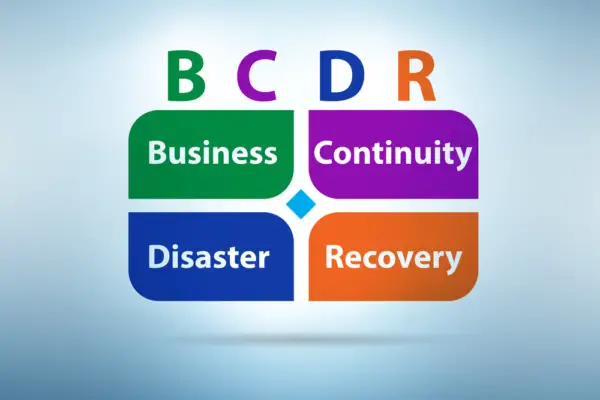A Business Continuity Plan (BCP) ensures an organization can continue operating during and after a disaster or disruption. The key components that contribute to the resilience of a BCP include:
- Risks and Potential Business Impact: Identifying and understanding their impact on business operations is critical. This involves assessing risks to determine threats and vulnerabilities that could disrupt business activities (QMS UK).
- Planning an Effective Response: Developing response strategies for how the organization will react to incidents and disruptions ensures a structured approach to managing and overcoming crises (QMS UK).
- Roles and Responsibilities: Clearly defining and assigning roles and responsibilities ensures team members know what is expected during a business disruption. This includes establishing a chain of command and communication protocols (QMS UK).
- Communication: A communication plan is vital to manage internal and external communications during a crisis. This includes contact lists, templates for messages, and protocols for communicating with stakeholders (QMS UK).
- Testing and Revision: Regularly testing the BCP through drills and exercises helps identify gaps and improvement areas. It’s also important to update the plan regularly to reflect any changes in the business environment or organizational structure (QMS UK).
Additional elements that can be considered part of a comprehensive BCP include:
- Initial Data: Important contact information and initial data at the beginning of the plan (TechTarget).
- Revision Management Process: A process for managing revisions to the plan to keep it up-to-date (TechTarget).
A Business Continuity Plan (BCP) is an essential blueprint for organizations to maintain operations during and after a disruptive incident.
It outlines procedures and instructions an organization must follow in the face of such emergencies, including natural disasters, cyber-attacks, or any other unforeseen events that could hinder business operations.
Developing a comprehensive BCP requires understanding the potential risks, performing a thorough risk assessment, and identifying crucial business processes that need to be sustained.
To create an effective plan, developing recovery strategies that can be implemented immediately after a disruption is necessary. It’s also vital for an organization to establish response and recovery teams with defined roles and responsibilities.
These teams are prepared to manage the crisis and communicate effectively with stakeholders during recovery. A strong focus on regular training, testing, and plan maintenance ensures that the BCP evolves in line with changing organizational needs and external requirements.
In addition, ensuring that the BCP adheres to compliance standards and proper documentation practices is critical for a complete and enforceable BCP.
Key Takeaways
- A BCP is a protocol for maintaining operations during crises.
- Recovery strategies and team roles must be clearly defined.
- Regular updates and adherence to standards are crucial for BCP effectiveness.
Understanding Business Continuity Planning
Business continuity planning establishes a framework for companies to maintain operations and protect their interests in the face of interruptions. This process is integral to an organization’s resilience and reputation management.

Definition and Importance of BCP
Business continuity planning (BCP) is a strategic approach businesses use to create systems of prevention and recovery from potential threats.
The importance of BCP lies in its ability to minimize the impact of disruptions on organizational activities, safeguarding both stakeholder interests and the company’s brand.
Key Elements of BCP
Objectives: The foundation of a business continuity plan is its objectives. These typically outline the critical functions to be maintained, the conditions for activation, and recovery targets.
Key Elements of a BCP typically encompass:
- Risk Assessment: Identifying threats that could cause disruptions.
- Business Impact Analysis (BIA): Determining the potential effect of an interruption on business operations.
- Recovery Strategies: Develop methods to maintain and restore business activities to operational levels.
- Plan Development: Documenting procedures and protocols to be followed during an incident.
- Testing and Maintenance: Regularly test the BCP to ensure effectiveness and update it as required.
These components coalesce to form a robust structure that supports a business’s ability to remain functional during and after a crisis.
Implementing a comprehensive BCP aids in upholding a company’s resilience, ensuring its reputation and operational capabilities are preserved.
Risk Assessment and Business Impact Analysis
In business continuity planning, two foundational elements are paramount: risk assessment and business impact analysis (BIA).
These processes determine the resilience of critical business functions, elucidate potential impacts of disruptions, and anchor the setting of recovery time objectives.
Conducting a Risk Assessment
Risk assessments are systematic processes to identify and evaluate potential risks that could disrupt business operations. They involve:
- Identification: Listing possible risks that could pose threats to business operations.
- Analysis: Assessing the likelihood and potential severity of each identified risk.
A thorough risk assessment informs the prioritization of resources to protect the most vulnerable areas of a business.
Performing Business Impact Analysis
A business impact analysis quantifies the effects of disruptions on critical business functions. This process encapsulates:
- Impact assessment: Determining the consequences of interruptions, including financial loss and reputational damage.
- Recovery Objectives: Establishing recovery time objectives (RTOs) for resuming business activities post-disruption.
Businesses can develop targeted recovery strategies that ensure continuity and minimize potential losses by assessing these components.
Developing Recovery Strategies
Developing robust recovery strategies is crucial for businesses to minimize the impact of disruptions and restore critical operations efficiently.
How an organization prepares for technology and data recovery and prioritizes its operations can distinguish between a quick return to normalcy and prolonged dysfunction.
Prioritizing Operations and Functions
In the wake of a disruption, it’s essential that a company quickly identifies its most critical functions. The goal is to ensure that these functions have the least downtime possible.
This involves conducting a business impact analysis to categorize and prioritize operations based on their importance to the business’s survival and financial and operational impacts.
For example:
- Tier 1: Essential functions without which the business will face legal or financial ramifications.
- Tier 2: Important functions that can be temporarily suspended but must be recovered within a specified timeframe.
- Tier 3: Non-essential functions can be restored after the primary business operations are stable.
Planning for Technology and Data Recovery
A significant aspect of recovery strategies involves planning IT infrastructure and data recovery. Disruptions to technology can halt many, if not all, business processes.
Thus, technology recovery strategies should focus on restoring hardware, software, data, and connectivity.
Key elements include:
- Data Backup: Regular data backups to on-site and off-site locations, ensuring copies are easily retrievable and secure.
- Redundant Systems: Having duplicate systems at a different location to provide continuity when primary systems fail.
- Disaster Recovery Plan: A delineated plan that outlines the steps for the quick restoration of IT operations in alignment with recovery time objectives.
Incorporating these strategies into a business continuity plan helps a business to bounce back from disasters promptly while safeguarding essential data and technological functions.

Establishing Response and Recovery Teams
In the architecture of a business continuity plan, delineating the structure and functions of response and recovery teams is paramount.
These teams are tasked with managing the immediate effects of a crisis and implementing the recovery process.
Defining Roles and Responsibilities
Key Personnel: Identifying and assigning specific roles and tasks to individual members within the response and recovery teams is imperative.
Those in leadership roles, such as the business continuity manager and the incident commander, should have clearly defined responsibilities, including decision-making authority, communication oversight, and overall response effort coordination.
- Team Composition:
- Incident Response Team: Handles immediate actions post-incident.
- Business Recovery Team: Focuses on long-term recovery strategies.
Stakeholders: Regular training and clear communication are essential to ensure each team member understands his or her duties and can execute the plan effectively when required.
Coordinating with External Vendors and Partners
Vendors and Business Partners: Their collaboration is essential for restoring services and maintaining operations. Therefore, agreements should be in place with third-party vendors and partners, outlining their role in the continuity efforts.
- Contact Lists: Maintain an up-to-date list:
- External Vendors: For restoring hardware/software.
- Service Providers: Ensuring utilities and essential services are prioritized.
- Emergency Responders: Quick access during a crisis.
People and Process Integration entail systematic coordination between internal teams and external entities. Clear communication channels must be established to facilitate effective partnership and response during an actual disruption.
Crisis Communication and Management
A well-articulated communication strategy and robust management processes are pivotal in a crisis. These elements ensure the preservation of trust and provide clear guidance to stakeholders.
Effective Communication During a Crisis
During a crisis, timely and accurate communication is crucial. The first step is establishing a crisis communications team with clear roles and responsibilities.
This team is responsible for crafting clear, consistent, and fact-based messages to minimize misunderstandings. They should use various channels to disseminate information to ensure it reaches all relevant stakeholders promptly.
- Channels of Communication: Use multiple channels such as emails, press releases, and social media to reach different audiences.
- Message Clarity: Keep messages concise and jargon-free.
- Consistency: Regular updates prevent the spread of misinformation and keep all parties informed about the evolving situation.
Managing Stakeholder Expectations
Effectively managing stakeholder expectations hinges on the transparency and regularity of updates provided. All actions taken by the company during a crisis should be communicated to the stakeholders to maintain confidence in the organization’s ability to handle the situation.
- Immediate Response: A prompt response outlining the initial steps can reassure stakeholders that the crisis is being managed.
- Progress Updates: Keep stakeholders informed about the progress in resolving the crisis to maintain trust.
- Feedback Mechanisms: Implement channels through which stakeholders can provide feedback and ask questions.
By integrating these practices into business continuity and crisis management plans, businesses can aim to mitigate the impact of a crisis while safeguarding their reputation and stakeholder relationships.
Training, Testing, and Maintenance
An effective Business Continuity Plan (BCP) hinges on the right mix of training for personnel, rigorous testing for effectiveness, and ongoing maintenance and updates. These elements ensure the plan is well-documented but also practicable and resilient in the face of disruptions.
Regular Training of Personnel
Regular training ensures employees know procedures and their roles during an incident. Training sessions can range from formal classroom settings to interactive drills, but they must address individuals’ specific actions to support the BCP.
Employees should be trained to follow the documented plan and adapt to disruptions that may require swift and decisive action beyond what is prescribed on paper.
Testing BCP Effectiveness
Testing the effectiveness of a BCP is crucial and can be conducted through various methods, including tabletop exercises, simulations, or full-scale walk-throughs.
Tabletop exercises typically involve key personnel discussing the response to a hypothetical situation, while simulations may encompass a more immersive scenario.
BCP testing aims to identify weaknesses and improve response times and coordination. The outcomes of these tests should be meticulously documented and analyzed for insights.
Updating and Maintaining the Plan
A BCP is not static; it requires regular updating and maintenance to remain effective. Changes in business operations, technology, or the regulatory environment necessitate revisions to the BCP.
Moreover, any lessons learned from testing and real incident responses should be incorporated into the plan. This might involve updating contact lists, technology recovery strategies, or procedures to manage potential threats that were not previously considered.
Regular reviews, at least annually or after significant business changes, can ensure the plan’s applicability in a dynamic business landscape.
Ensuring Compliance and Documentation
When developing a business continuity plan, it’s crucial to maintain compliance with legal and regulatory standards and to have all associated documentation properly created and securely stored. This ensures not only the effectiveness of the plan but also its adherence to mandatory practices.
Adhering to Legal and Regulatory Requirements
Organizations must comply with various legal and regulatory requirements pertaining to their operations. This often includes meeting standards set by frameworks such as ISO 22301, which specifies the requirements for a management system to protect against, reduce the likelihood of, and ensure recovery from disruptive incidents.
They should conduct a thorough compliance checklist review aligning with industry-specific regulations and international standards to ensure all compliance aspects are covered. Moreover, governance structures within the organization play a key role in overseeing the adherence to these requirements.
Creating and Storing Documentation
The backbone of any effective business continuity plan is its documentation. Creating comprehensive templates that can be customized for different scenarios is vital.
These documents should be clear, concise, and easily accessible to all stakeholders. It’s imperative to maintain these documents in a secure yet accessible manner, which involves regular updates and backups.
Furthermore, documentation is not limited to the plan itself but also includes records of training, exercises, maintenance logs, and recovery procedures to be well-documented.
This meticulous approach ensures the organization demonstrates its commitment to business continuity and ability to respond to incidents effectively.
Technology and Infrastructure Resilience
In business continuity, technology and infrastructure resilience are paramount to maintaining operations during disruptions, whether from cyberattacks or other sources.
Firms must prioritize fortifying their IT services and protect vital data through strategic planning and up-to-date solutions.

Leveraging Cloud and Data Protection
The inclusion of cloud-based solutions is critical to any modern business continuity plan. Companies can enhance resilience by utilizing the cloud for data storage and computing resources, providing a scalable and flexible environment.
Data protection measures, such as regular backups and robust encryption, safeguard against data loss from cyberattacks and facilitate a quicker recovery. Firms should incorporate:
- Real-time backup strategies.
- Encryption protocols.
- Access control mechanisms.
Cloud services offer these features, often with lower costs and greater reliability than traditional on-premises solutions.
Building Robust IT Services
Organizations must construct robust IT services to withstand digital transformation challenges and bounce back swiftly from interruptions.
This entails designing an IT infrastructure with redundant systems and paths to prevent single points of failure. Continuous monitoring for potential cyberattacks helps minimize risk. Operational strength is further secured through the following:
- Distributed networks.
- Redundant hardware.
- Regular update and patch management.
Businesses must ensure that IT services align with their digital transformation goals, emphasizing flexibility and the capacity to adapt to new technological advancements while defending against evolving cyber threats.

Chris Ekai is a Risk Management expert with over 10 years of experience in the field. He has a Master’s(MSc) degree in Risk Management from University of Portsmouth and is a CPA and Finance professional. He currently works as a Content Manager at Risk Publishing, writing about Enterprise Risk Management, Business Continuity Management and Project Management.

